Wire Mesh
Wire mesh, also known as wire cloth, is an industrial material crafted from interlocking metal wires that are woven, welded, or sintered together. It features consistent, evenly spaced openings for precise performance in various applications.
Wire Mesh FAQs
What is wire mesh used for in industrial applications?
Wire mesh is used for filtration, screening, separation, and structural reinforcement across industries such as construction, food processing, and mining. Its strength and consistent openings make it ideal for filtering fluids, gases, and particles in demanding environments.
How is woven wire mesh different from welded wire mesh?
Woven wire mesh is created by interlacing perpendicular wires, offering flexibility and precision. Welded wire mesh joins intersecting wires with electric welds for superior rigidity, making it better suited for structural and heavy-duty applications like fencing or reinforcement panels.
What materials are most commonly used to make wire mesh?
Common materials include stainless steel, galvanized steel, copper, aluminum, and carbon steel. Each offers unique benefits—stainless steel resists corrosion, copper conducts heat and electricity, while galvanized coatings enhance longevity in humid or outdoor settings.
What is mesh count and why is it important?
Mesh count measures the number of openings per linear inch of wire mesh. A higher mesh count provides finer filtration, while lower counts offer more open area for bulk materials or larger particles. It’s a critical factor for filtration and screening precision.
How does galvanization improve wire mesh durability?
Galvanization coats the wire with zinc, providing a protective barrier against corrosion and rust. This process significantly extends the lifespan of wire mesh, especially in moisture-rich environments or outdoor industrial applications across the Midwest and coastal regions.
What are the main weaving styles used in wire mesh production?
Common weaving styles include plain weave, twill weave, plain Dutch weave, and Dutch twill weave. Each pattern affects strength, flexibility, and filtration precision. Crimped variations like lock crimp or flat-top add extra stability for larger-spaced meshes.
Why is wire mesh preferred over perforated metal in some applications?
Wire mesh provides uniform openings created through weaving or welding, offering precise control for filtration and screening. Perforated metal, formed by punching or stamping, suits decorative or structural uses but lacks the same flexibility and fine control of woven mesh.
The History of Wire Mesh
The origins of wire cloth trace back to ancient Egypt, where artisans wove precious metals like gold and silver into intricate designs, creating jewelry fit for the wealthy. For centuries, wire cloth remained exclusively ornamental, serving as a status symbol among the elite.
By the 5th century, wire cloth took on a new role in warfare. Skilled craftsmen began weaving iron and other metals into chain mail, offering soldiers a revolutionary form of protection. Unlike rigid metal armor, chain mail provided flexibility, allowing for greater mobility in battle. As its value became evident, kingdoms took control of its production and distribution, regulating sales and exports since chain mail often determined the outcome of wars.
As chain mail spread throughout the Western world, it laid the foundation for the wire working and wire drawing industries. Metalworkers expanded their craft, producing a variety of wire-based products, including birdcages, mousetraps, windows, chains, and hooks.
The Industrial Revolution marked a turning point for wire mesh manufacturing. Steam-powered weaving looms automated production, making wire cloth more accessible and widely used. Industries quickly adapted wire mesh for various applications, from reinforcing maritime sails to flame-arresting gauze in mining and fine mesh screens in paper production.
The 20th century saw another surge in wire mesh applications, particularly during wartime. Manufacturers incorporated wire mesh into military equipment, including tanks, vehicles, and aircraft. During World War I, when chemical warfare became widespread, wire cloth played a critical role in the development of gas masks.
Today, wire mesh continues to evolve, finding applications in construction, food processing, and even decorative design. Its versatility and durability ensure its relevance across countless industries, proving that this once-luxurious material has become an indispensable part of modern life.
Benefits of Wire Mesh
Wire mesh stands out for its strength and precise aperture size, making it an essential material in the production of filtration equipment for fluids, gases, and particles. Its versatility allows it to be fabricated into a form as delicate as silk or as rigid as stainless steel. Additionally, wire mesh is cost-effective and easily customizable to meet specific application needs.
Mesh Process Details
Wire mesh products are typically produced through weaving or welding. In some cases, manufacturers also knit or sinter the wire. While sintered wire mesh is more expensive than its woven or welded counterparts, it offers superior structural stability, making it ideal for transporting bulk materials and powders.
- Weaving Wire
- Modern looms weave wire mesh in a right-angled pattern, with variations depending on the chosen weaving and crimping methods. In a plain weave, each weft wire alternates over and under each warp wire, whereas a twilled weave interlaces the weft wire over and under two warp wires. Crimping adds corrugations to the wires, securing them together at perpendicular intersections. Once woven, wire mesh is typically stored in large rolls until needed, when it is cut and shaped into the required form.
- Welding Wire Mesh
-
For applications requiring enhanced rigidity and strength, manufacturers use electric welding to join metal wires at their intersection points. This ensures the mesh remains intact even under pressure or when cut. Additional shaping processes such as bending and trimming finalize the welded wire cloth.
- Finishing Wire Mesh
- Wire mesh undergoes various finishing treatments to enhance durability. Galvanization is a common method used to reinforce the material and protect it from corrosion. This process is especially beneficial for fine wire mesh used in screens, as it prevents the woven structure from unraveling over time.
Designing Wire Mesh
Manufacturers design wire mesh with the intended application in mind, knowing that the weave pattern directly impacts key characteristics such as strength, flexibility, open area, and mesh count. The purpose of the mesh—whether for inclusion or exclusion—also influences design choices. Inclusion applications allow the passage of liquids or processed fluids, while exclusion applications restrict particles.
While custom weaving and welding are common, manufacturers also work with established weave patterns. Pre-crimped wire mesh can feature several distinct weaves:
- Double Weave – Each vertical (warp) wire alternates over and under two horizontal (weft) wires, creating a structured, reinforced pattern.
- Lock Crimp – Deep crimps in the wire interlock at each intersection, ensuring a secure fit with a standard plain weave pattern.
- Flat Top – A smooth-surfaced weave where the weft wires are heavily crimped to lock them in place, while the warp wires remain uncrimped.
- Intermediate Crimp – Used when more open area is needed, this weave adds extra crimps for enhanced stability in larger-spaced meshes.
Non-crimped wire mesh can be woven in the following styles:
- Plain Weave – The simplest weave, alternating each warp and weft wire over and under one another. Commonly found in window and door screens.
- Twill Weave – Each warp wire passes over and under two weft wires, creating a staggered, reinforced structure suitable for thicker wire diameters.
- Plain Dutch Weave – Similar to plain weave but with tightly spaced weft wires. Typically, the warp wire has a larger diameter. The reverse Dutch variation features a smaller-diameter warp wire.
- Dutch Twill Weave – A hybrid of Dutch and twill weaves, featuring a double-layer structure with densely packed weft wires. This design eliminates openings, making it ideal for filtering non-particulate fluids.
Wire mesh can be further customized with crimping for added stability, specialty weaves for specific applications, variations in wire thickness, mesh size, and mesh count. Additional coatings, such as PVC, enhance resilience, corrosion resistance, and insulation.
Wire Mesh Images, Diagrams and Visual Concepts
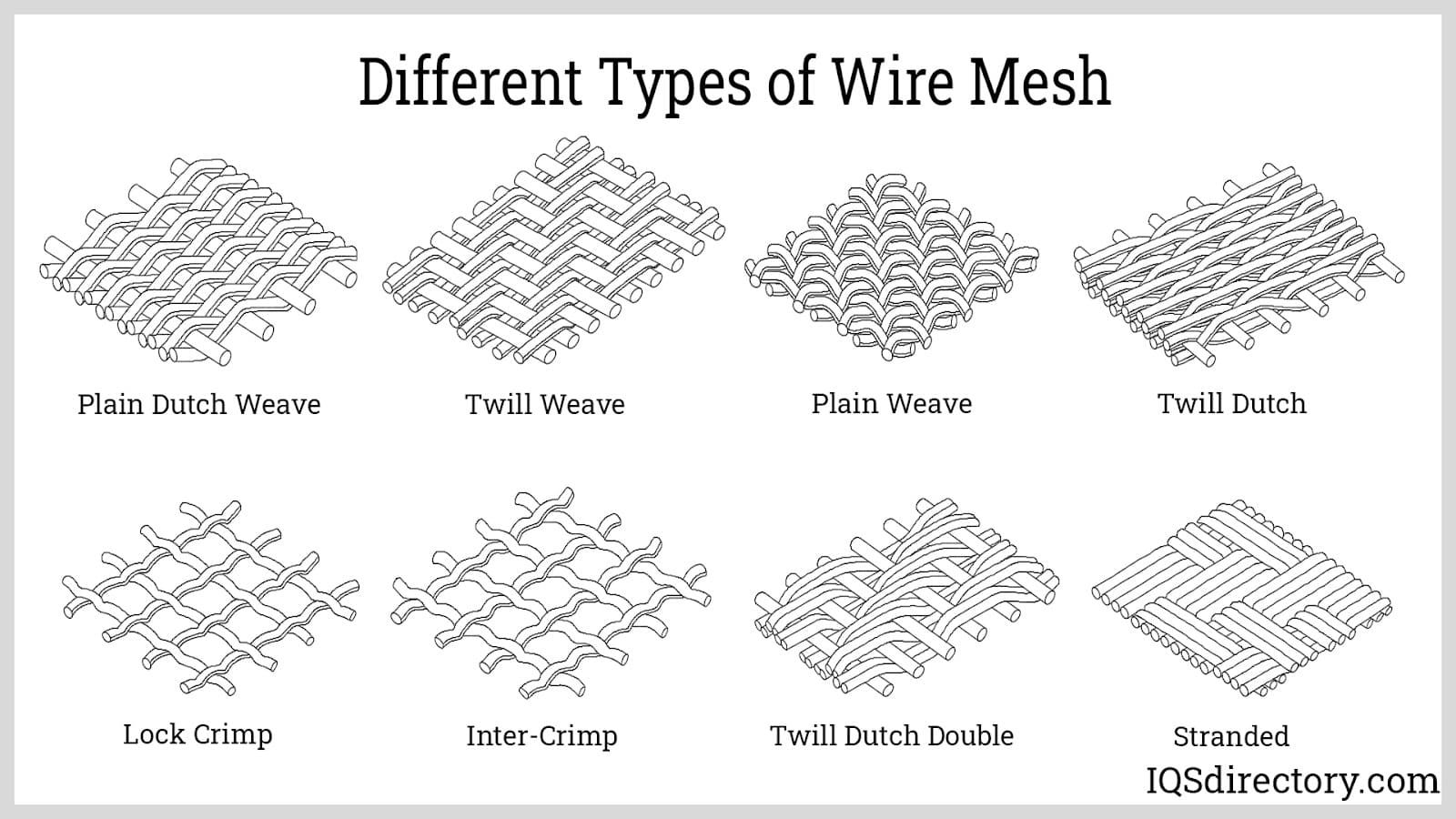 There are a limitless number of shapes, sizes, and configurations of wire mesh made from an assortment of highly durable and resilient materials.
There are a limitless number of shapes, sizes, and configurations of wire mesh made from an assortment of highly durable and resilient materials.
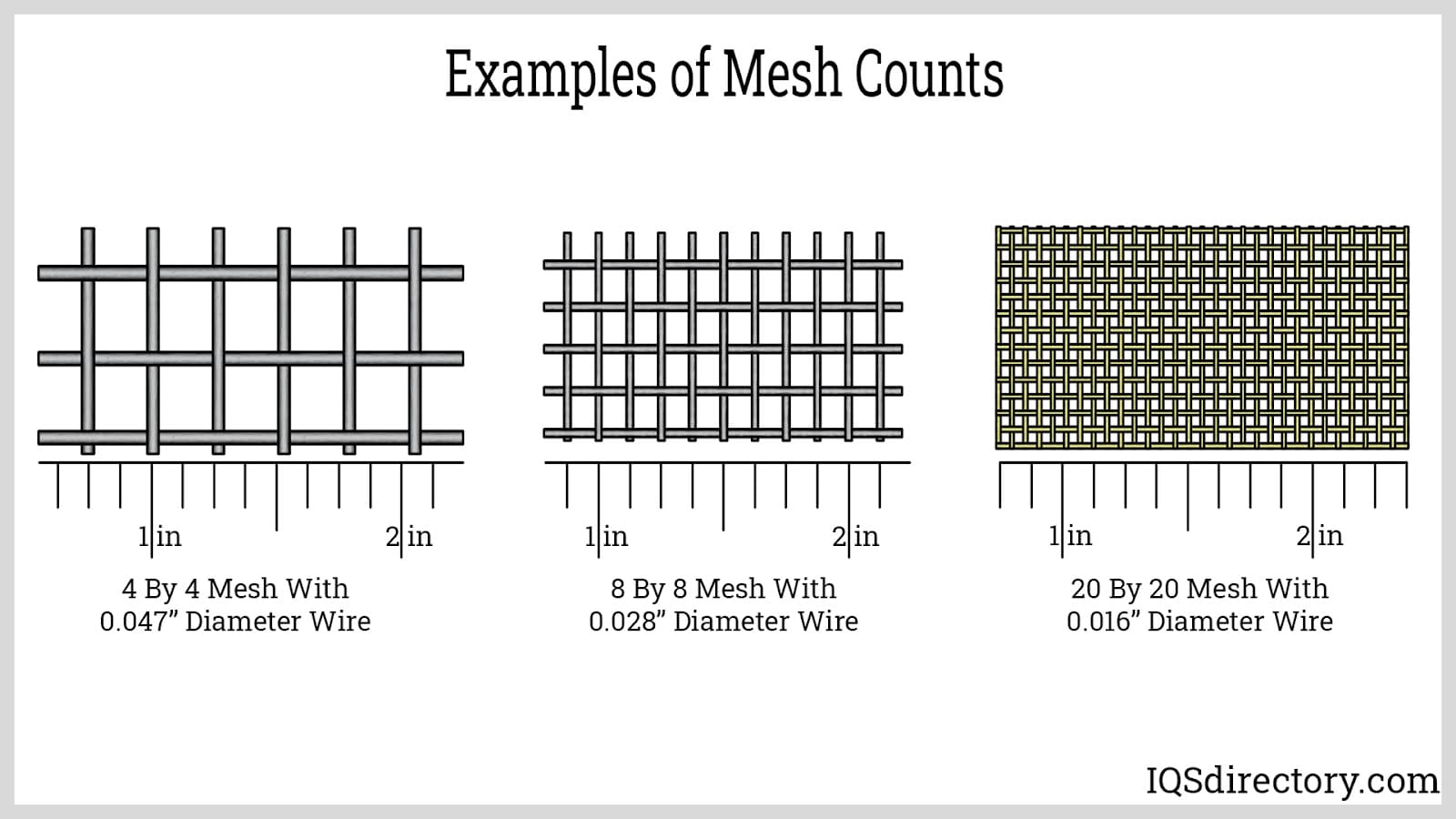 Mesh count refers to the number of openings per linear inch in wire mesh and is determined by counting the number of openings in one linear inch from the center wire of a wire mesh.
Mesh count refers to the number of openings per linear inch in wire mesh and is determined by counting the number of openings in one linear inch from the center wire of a wire mesh.
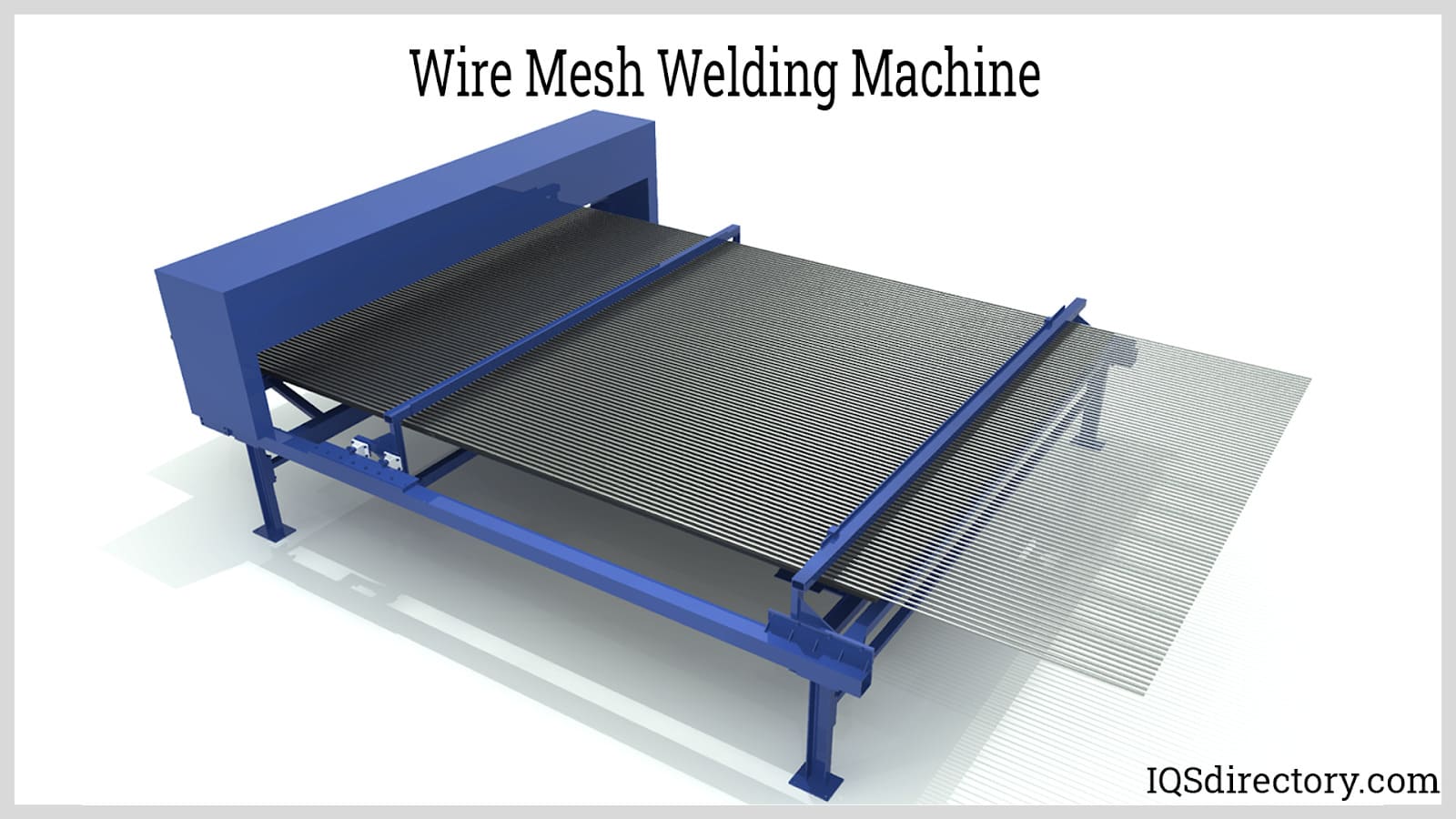 Wire mesh uses a semi-automatic process that welds the intersections of the woven wires at horizontal and vertical aligns.
Wire mesh uses a semi-automatic process that welds the intersections of the woven wires at horizontal and vertical aligns.
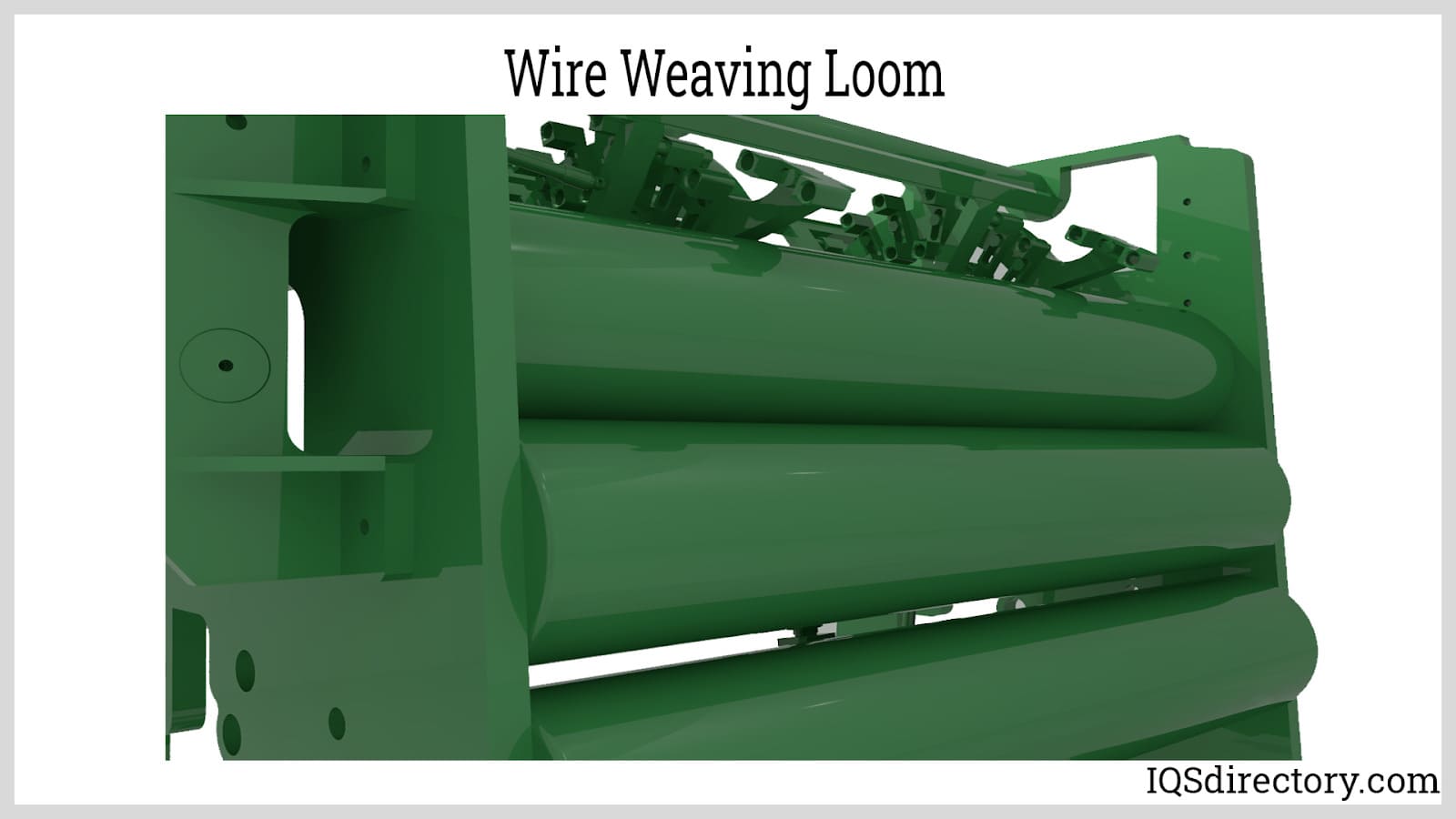 Wire looms weave meshes of standard and custom patterns by cutting varying lengths depending on the specifications.
Wire looms weave meshes of standard and custom patterns by cutting varying lengths depending on the specifications.
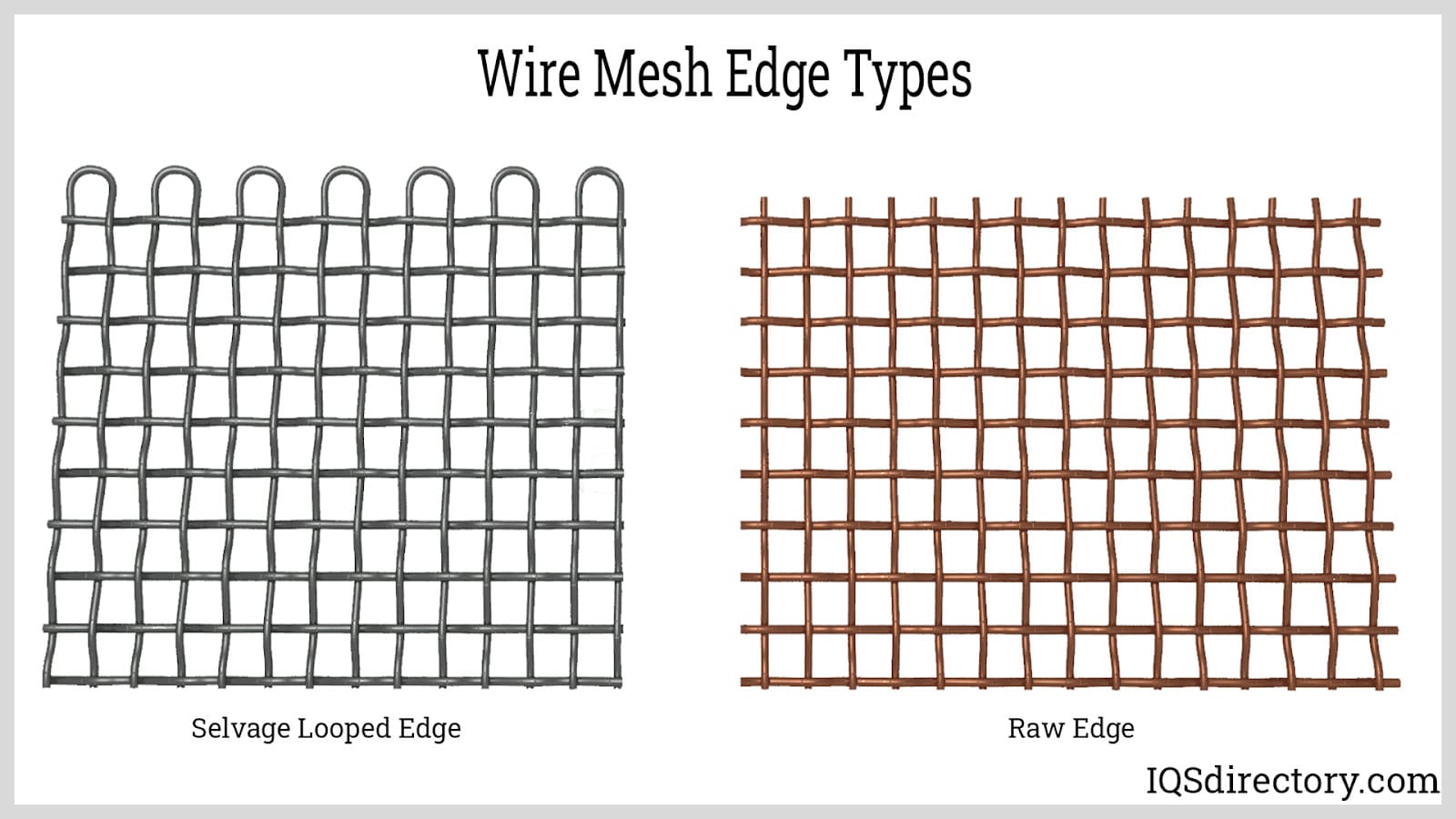 When wire mesh cloth is woven, the weft wires forms an edge along the length of the roll which prevents the mesh from unraveling.
When wire mesh cloth is woven, the weft wires forms an edge along the length of the roll which prevents the mesh from unraveling.
 Carbon plain steel is mainly iron with a small amount of carbon which makes it low-cost and versatile.
Carbon plain steel is mainly iron with a small amount of carbon which makes it low-cost and versatile.
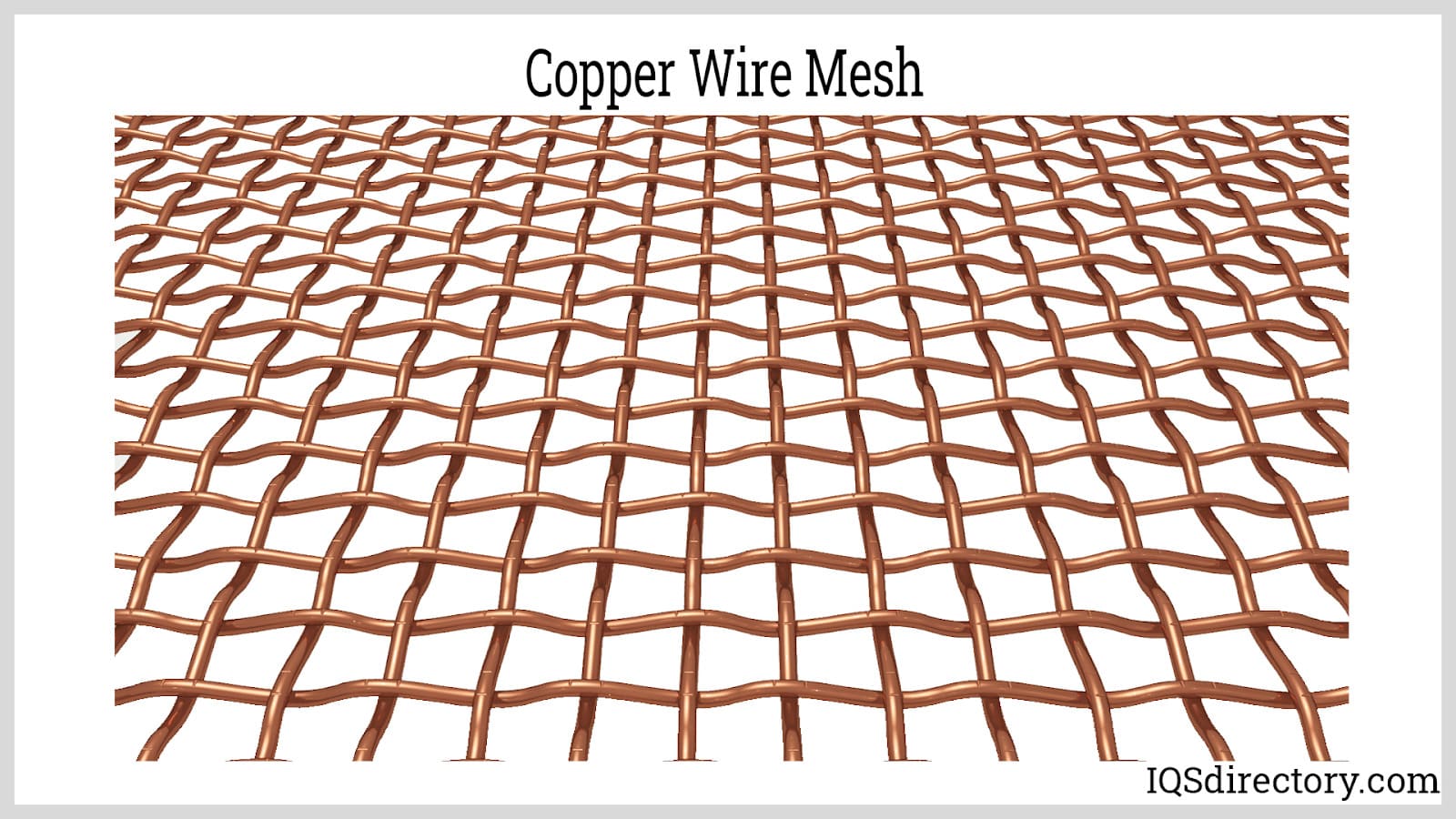 Copper wire mesh has exceptional thermal and electrical conductivity and is ductile and bendable.
Copper wire mesh has exceptional thermal and electrical conductivity and is ductile and bendable.
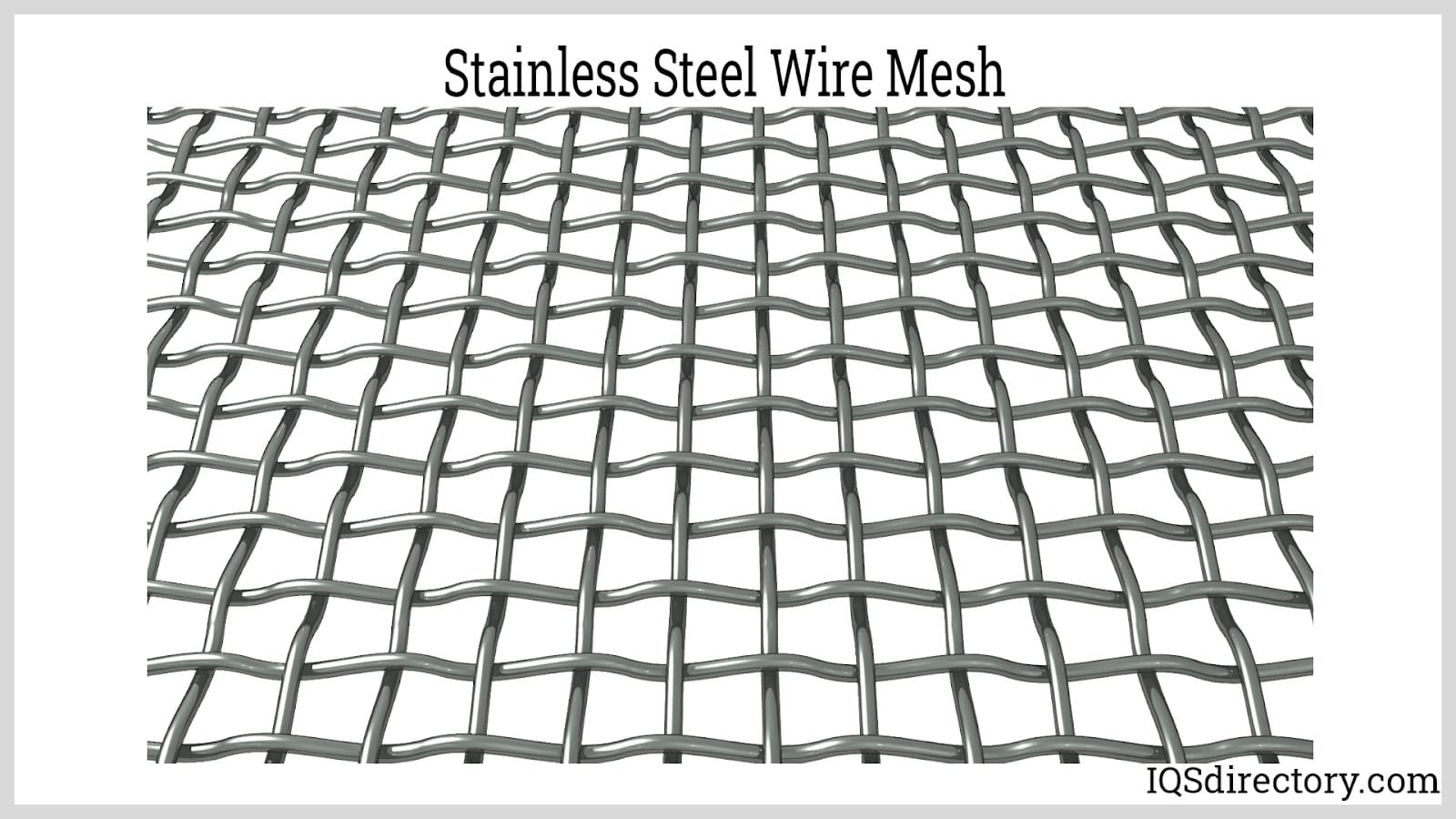 Stainless steel wire mesh is dependability, sturdy, and rust resistant.
Stainless steel wire mesh is dependability, sturdy, and rust resistant.
 Galvanized wire mesh is coated with zinc to prevent corrosion and rust.
Galvanized wire mesh is coated with zinc to prevent corrosion and rust.
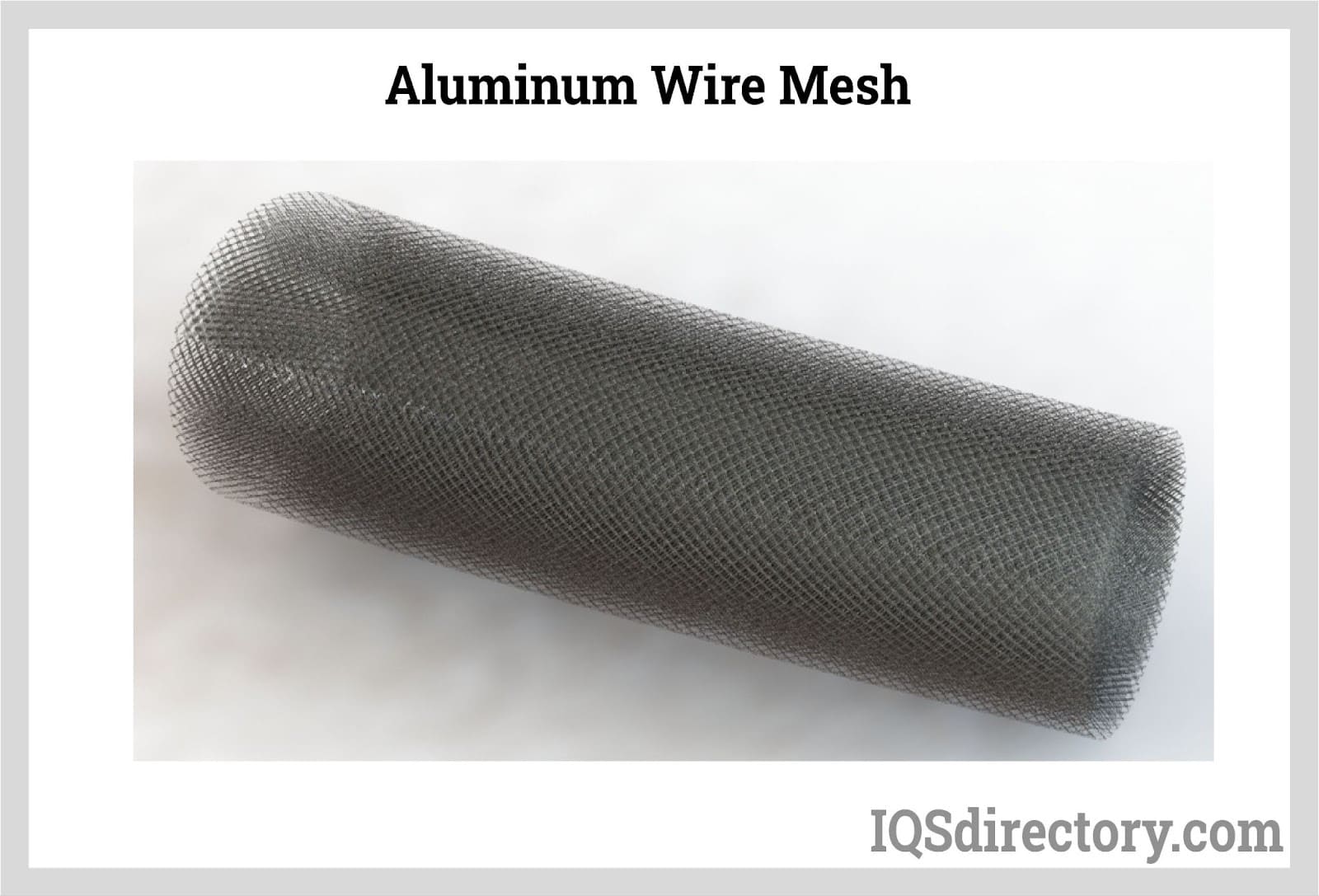 Aluminum wire mesh is inexpensive, lightweight, malleable, flexible, and resistant to corrosion.
Aluminum wire mesh is inexpensive, lightweight, malleable, flexible, and resistant to corrosion.
Wire Mesh Types
- Backing Cloth
- Backing cloth is wire cloth or mesh designed to reinforce and support the surface of screens, providing structural integrity during use.
- Bolting Cloth
- Bolting cloth consists of stainless steel mesh woven in a plain construction using fine-diameter wires. This design achieves a high percentage of open area, ideal for precision screening and filtration.
- Cloth Baskets
- These baskets are crafted from wire cloth shaped within sturdy frames of rod, flat stock, or angle material. For handling small parts, cloth baskets often feature a heavier outer screen layer, enhancing protection and durability.
- Copper Screens
- Copper screens serve diverse purposes, including electromagnetic shielding, Faraday cage construction, insect screening, and papermaking. Known for their ductility, copper meshes bend easily and retain their shape with minimal springback.
- Filter Cloth
- Specifically engineered for filtration and straining tasks, filter cloth features varied wire diameters and patterns, woven in plain or twill weaves with an increased wire count in one direction for enhanced filtering efficiency.
- Galvanized Wire Mesh
-
Galvanized wire mesh comprises interlocking metal wires coated with zinc, providing improved corrosion resistance and longevity.
- Hardware Cloth
- Hardware cloth refers to welded, galvanized wire mesh widely used for protective barriers, fencing, and various construction projects.
- Metal Screening
- Metal screening describes versatile mesh materials employed across various applications for screening and barrier purposes.
- Screen Cloth
- Screen cloth is a specialized wire mesh intended primarily for filtration and straining processes, offering precise, consistent performance.
- Sieves
- Sieves consist of mesh baskets designed specifically for separating, sifting, and straining solid particles from liquids or fine materials.
- Square Mesh Cloth
- This cloth is woven with uniform wire diameters and identical mesh counts in both directions, providing consistent filtration characteristics.
- Stainless Steel Screens
- Stainless steel screens are essential in food processing, plumbing, and similar applications requiring corrosion resistance. Their durable construction enables effective sifting and screening.
- Stainless Steel Screen Cloth
- Widely utilized for its excellent strength and corrosion resistance, stainless steel screen cloth features uniform square mesh openings, suitable for various filtration and protection applications.
- Steel Mesh
- Steel mesh crafted from standard steel offers toughness, temperature resistance, and cost-effectiveness. Uncoated standard steel mesh, however, should be kept from frequent or prolonged exposure to moisture, while stainless steel mesh provides superior water resistance.
- Strainers
- Strainers are woven wire cloth products used extensively to prevent clogging by filtering, draining, straining, and sifting liquids and solids across multiple industries.
- Test Sieves
- Test sieves encompass diverse styles such as half-height, microplate, wet-washing, extra-depth, air-jet, and grain sieves. Precision-engineered, these sieves feature sealed frames, reinforced rims, and evenly tensioned mesh for reliable laboratory and testing procedures.
- Welded Wire Mesh
- Produced by welding intersecting metal wires at perpendicular angles, welded wire mesh delivers exceptional strength and rigidity, making it indispensable in fencing, construction, and engineering fields.
- Wire Screens
- Wire screens are finely woven meshes with square-weave patterns, creating open yet protective barriers suitable for numerous applications requiring visibility and security
- Woven Wire Mesh
- Woven wire mesh, an alternative to welded mesh, involves interlacing perpendicular wires together, offering flexibility, strength, and versatility across various filtering, screening, and protective applications.
Wire Mesh Applications
Wire mesh manufacturing serves diverse purposes across many industries, primarily focusing on tasks involving separation, filtration, screening, structural reinforcement, and shielding.
Beyond these fundamental uses, wire cloth proves essential in specialized applications, including watermarking currency, shielding against radio and microwaves, aiding plastic extrusion processes, manufacturing optical lenses, forming transportation belts, and diffusing heat, flames, and light.
Numerous industries rely on wire mesh solutions, from food and beverage processing, pharmaceutical and petrochemical production, and automotive manufacturing, to pulp and paper industries, screen printing, HVAC systems, home appliance fabrication, mining operations, flooring production, battery manufacturing, and broader industrial manufacturing.
Initially, manufacturers shape raw wire into versatile base products like woven wire mesh, welded wire mesh (hardware cloth), fine wire cloth, square mesh, strong wire cloth, wire forms, and diamond mesh. These foundational materials act as starting points—flexible and adaptable—enabling manufacturers to craft specialized finished products such as window screens, decorative meshes, cooking strainers, flour sifters, filtration components, animal enclosures, poultry netting, industrial sieves and screens, catalytic converters, protective barriers and equipment, screen mesh cloth, and durable floor gratings.
Materials Used in Wire Mesh
The most common metals and alloys used for making wire cloths are:
- Low-Carbon Steel
- Often referred to as plain steel, low-carbon steel exhibits moderate resistance to corrosion and abrasion. Wire mesh constructed from low-carbon steel is generally viewed as lower quality for environments with high moisture. Nonetheless, its notable impact resistance and tensile strength make it suitable for a wide range of general applications, including metal mesh and hardware cloth. Galvanizing the steel significantly enhances its strength and durability.
- High-Carbon Steel
-
Naturally more resistant to abrasion and corrosion, high-carbon steel typically eliminates the need for galvanization. It is frequently employed in manufacturing vibrating filter screens designed for rigorous sorting and sifting of abrasive materials such as stone, gravel, and coal.
- Stainless Steel
- For applications demanding superior quality, stainless steel wire mesh stands out due to its exceptional resistance to corrosion. Depending on specific application requirements, stainless steel mesh can be processed to either possess or lack magnetic properties. Furthermore, the inclusion of metals like titanium, chromium, nickel, and molybdenum allows manufacturers to create customized stainless steel meshes with enhanced characteristics, such as improved heat and moisture resistance or increased shock absorbency.
- Copper
- Copper is the preferred material when wire mesh applications require excellent thermal and electrical conductivity. Its inherent resistance to salty and corrosive environments further enhances its suitability for chemically challenging conditions. Despite these advantages, copper's softness results in limited tensile strength and poor abrasion resistance. To address these limitations, copper wire mesh often incorporates zinc alloys; however, this alloying reduces the copper mesh's conductivity.
- Aluminum
- Aluminum wire mesh is selected for applications where lightweight construction is critical. With its natural resistance to corrosion and impressive strength-to-weight ratio, aluminum mesh is particularly well-suited for marine environments. Typically, aluminum alloys such as 5056 are chosen over pure aluminum to achieve enhanced durability and performance.
- Nickel
- Pure nickel is seldom utilized for wire screens or wire forms due to its relatively weak corrosion resistance, which leads to oxide layer formation on its surface over time. Consequently, manufacturers favor nickel alloys such as Monel, Hastelloy B, Hastelloy C, and Carpenter 20 CB-3 for applications requiring robust corrosion-resistant wire mesh.
Machinery Used For Wire Mesh Creation
Manufacturers produce wire mesh on automated looms specifically engineered for the precise task of wire weaving. These advanced looms offer versatility, allowing for customization across multiple parameters such as weaving scope, mesh counts, square hole size ranges, crankshaft rotating speeds, motor power ratings, and overall equipment weight. By adjusting these settings, manufacturers achieve precise, consistent results tailored to unique application requirements.
Variations to Wire Mesh
Wire mesh is distinctly different from perforated metal in manufacturing methodology. Wire mesh involves intertwining or welding individual wire strands on automated looms, creating consistent, controlled patterns of openings. In contrast, perforated metal fabrication uses punch presses, stamping machines, and advanced laser cutting systems to mechanically create holes, slots, or decorative shapes directly into metal sheets. While wire mesh depends on weaving or welding wires to form structured grids, perforated metal relies entirely on mechanical stamping, achieving unique patterns and customized designs.
Things to Consider When Purchasing Wire Mesh
Finding the ideal wire mesh product involves collaborating with a knowledgeable, experienced supplier. An effective approach begins by connecting with the reputable manufacturers listed above. Explore their individual websites thoroughly, then select three or four that align closely with your needs. Provide each supplier a detailed explanation of your specific application, clearly outlining all requirements and expectations. Engage proactively by asking insightful questions to clarify their capabilities, manufacturing methods, lead times, and customization options. Carefully evaluate their responses, comparing their experience, responsiveness, product quality, and ability to meet your specific needs. By taking this detailed approach, you’ll confidently choose the right wire mesh partner for your project.
Wire Mesh Terms
- Aperture
- The measured space between adjacent parallel wires, specified in millimeters.
- Bands
- Materials made of steel, galvanized steel, or stainless steel, utilized to reinforce and stabilize the edges of the screen.
- Bend Test
- A procedure where wire is repeatedly bent around a defined diameter and angle for a set number of cycles, assessing the wire’s ductility, integrity, and toughness.
- Blinding
- The obstruction of wire mesh apertures caused by the entrapment of particles from process materials.
- Bubble Point Test
- A testing method for determining average aperture size. Air pressure required for bubbles to penetrate mesh covered with a testing liquid is measured, considering factors like surface tension, liquid density, temperature, and immersion depth.
- Calender
- Also termed “rolled,” this process involves passing wire cloth through two rollers to decrease thickness, flatten wire intersections, and create a smooth surface.
- Coin
- Stamping wire cloth to compact, shape, or seal it, thus preventing the mesh from unraveling.
- Count
- A measurement specific to mesh wire cloth, indicating the number of openings per linear inch, measured from the center of one wire to the next.
- Crimp
- Intentional corrugations in wire designed to securely hold intersecting wires perpendicular to one another.
- Double Crimp
- A weaving preparation where wires are crimped before weaving, resulting in both shute and warp wires being crimped at each intersection.
- Feather Edges
- Straight, non-crimped wire ends protruding uniformly around the perimeter of a screen cloth section, remaining on the same plane.
- Gauge
- The original diameter of the wire before the weaving process.
- Heated Deck
- A screening surface heated via screen cloth acting as a heating element, commonly fabricated from stainless steel.
- Intermediate Crimp
- A crimping pattern where both shute and warp wires intersect at every alternate crimp.
- Market Grades
- The most frequently used industrial wire cloth specifications designed for general-purpose applications, typically available for immediate shipping from suppliers.
- Mesh Count
- A numeric expression of openings between intersecting wires per linear inch, indicative of weave size and, thus, filtering capability.
- Offal
- Surplus wire screen material removed from standard rolls during cutting, slitting, or fabrication.
- Open Area
- The percentage ratio of open spaces to the total surface area of a wire screen.
- Selvage
- A finished edge created along the length of wire mesh rolls to prevent wires from unraveling.
- Shute Wires
- Also known as “weft,” “shot,” “shoot,” or “fill” wires, these wires run horizontally across woven cloth and are maneuvered back and forth via the shuttle during weaving.
- Warp Wires
- Lengthwise wires across wire cloth, initially positioned during the weaving preparation known as “warping the loom” at specified intervals.